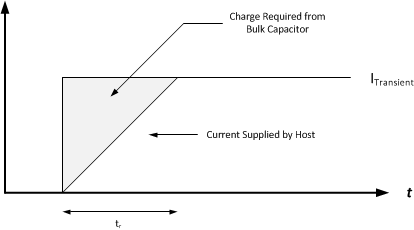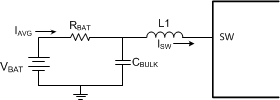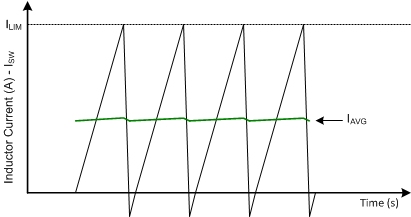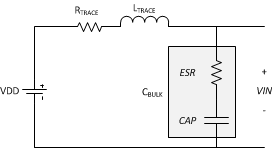SLOA198A September 2014 – December 2021 DRV2665 , DRV2667 , DRV2700 , DRV8662
- Trademarks
- 1 Boost Converter Basics
- 2 DRV8662, DRV2700, DRV2665, and DRV2667 Boost Converter
- 3 Configuring the Boost Converter
- 4 Boost Converter Output Voltage
- 5 Calculating the Load Current
- 6 Selecting an Inductor
- 7 Calculate the Maximum Boost Current
- 8 Output Capacitor Selection
- 9 Input Capacitor Selection
- 10PCB Layout
- 11Examples
- 12Revision History
9 Input Capacitor Selection
The input capacitor provides current to the DRVxxxx when there are large current transients during startup and heavy load periods.

When a bulk input capacitor is included, the following diagram shows that the battery actually sees a filtered version of ILIM.

When the boost converter enters a heavy load condition or during a startup sequence, the switching frequency reaches a maximum value set by the slope of the charge/discharge curve and the ILIM value.

Calculating the exact IAVG value is rather difficult, but as long as the bulk decoupling capacitance in the system is sufficiently high, the average current drawn from the battery will be less than one-half of ILIM as a general guideline.
To estimate the bulk input capacitor value, use Equation 11.

| Symbol | Description | Value | Unit |
|---|---|---|---|
| CBULK | Minimum VDD bulk capacitance required | – | F |
| ITR | Input transient current (maximum is ILIMIT) | – | A |
| LTrace | Input trace inductance (estimate 50 nH, if unknown) | – | H |
| VDROOP | Maximum boost output voltage droop (Ex.: 3.6 V – 0.1 V = 3.5 V, 0.1 V is the allowable droop) |
– | V |
This equation was derived from the RLC circuit formed by the trace resistance and inductance combined with the bulk capacitance and capacitor ESR.

Keep in mind that it is difficult to calculate the exact input current required for the DRVxxxx, so a minimum capacitance between 22 µF and 47 µF is recommend.